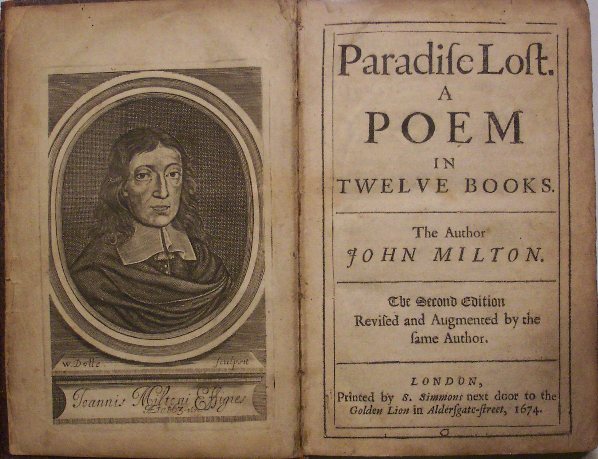blank verse: unrhymed iambic pentameter, meter in which PL is written, and which Milton defends in “The Verse” paragraph that precedes the poem
epic: literary form from the ancient world, usually a long narrative poem that tells the story of a people, with a hero who performs great deeds
Homer, Odyssey, Iliad: ancient Greek epics, each in 24 books, neither widely read or known in original language until 16th c., or in English translation until the 18th c. by Pope (Iliad 1715-20)
Virgil, Aeneid: ancient Roman epic, very much in competition with Homer, 12 books, always known to the West, most often a school text in Latin, tr. by Dryden (1697)
Ovid, Metamorphoses: “alternative” epic, 15 books, taught the West its Greco-Roman mythology invocation: convention in which poet asks Muse for help in writing at beginning of epic
argument: means “summary” or “theme” in Milton’s time
Muse: classical personification of poetical inspiration
in medias res: lit. “in the middle of things,” where epic generally starts—i.e., the epic begins in the middle of the story; the middle of the epic recounts the beginning of the story. The film Forrest Gump has almost precisely this structure
There were two eds. of PL in Milton’s lifetime, one in 10 books (1667), the other in the more Virgilian 12 books (1674).
Milton is almost completely blind by 1651. Nevertheless he is Oliver Cromwell’s Secretary for Foreign Tongues and writes justifications for the regicide up until the eve of the Restoration. Marvell and Dryden work in the office with him.
typology: mode of Biblical interpretation which holds that the events of the New Testament—especially anything concerning the life, ministry, sayings, crucifixion, and resurrection of Jesus—are said to be foretold by the stories, sayings, and events of the Old Testament: e.g., Jonah and the whale, Abraham and Isaac, Isaiah’s prophecy about the Messiah, and whatnot
fortunate fall: perhaps the ultimate example of typology: the Fall in Eden is a good thing because it necessitated the entrance of Christ into history. Without Adam’s disobedience, there is no need for a Christ, “Second Adam,” to redeem us from Original Sin
there were four accepted ways of reading the Bible, and it was alleged that any passage from Scripture could be read in all four of these methods: literal (historical); allegorical-typological (what you must believe); moral (what you must do); eschatological-anagogical (your future destination; mystical, four last things)
Grandmother Eve: conception of her that blames women exclusively for the Fall and thereby justifies their oppression and containment by men; Biblical justification said to be 1 Timothy 2.13-14: “For Adam was first formed, then Eve. And Adam was not deceived, but the woman being deceived was in the transgression”
heresy: idea or concept in conflict with the orthodoxy of a religion
teleology: philosophy about rank and order in the universe
theology: study of religion
There were allegedly nine orders of angels, divided into three choirs: Seraphim, Cherubim, Thrones; Dominions, Virtues, Powers; Principalities, Archangels, Angels
Reformation: social and political as well as religious movement in Western Europe in the early 16th c. For nationalistic and economic as well as theological reasons, states formed national churches and broke with Rome in various degrees, so-called Protestants
Martin Luther: German reformer, father of the Reformation with his tripartite program: sola gratia (God’s Grace alone will save you, not an act of individual will); sola scriptura (Scripture, not doctrine); sola fide (faith over works)
John Calvin: French reformer with his colony in Geneva, extreme and ascetic type of Protestantism: mankind totally depraved, desperately in need of grace
predestination: most notorious Reformation doctrine—all foreknown in the mind of God eternally, especially one’s salvation or damnation
Henry VIII: once Defender of the Faith for the Pope against the Lutheran heresy, persecutor of Protestants, then architect of Reformation in England
Jacobus Arminius: theologian who disputed radical notions of reformers, argued that we have free will, standard position of Rome, argued by Erasmus v. Luther, known as Arminianism
John Knox: Scottish reformer, disciple and interpreter of Calvin for English-speaking people, crucial to reform movements in Church of England, father of Presbyterianism
Counter-Reformation: Rome’s response to Protestant heresy, its legal wing known as the Inquisition, its main order known as the Jesuits, whose founder was Ignatius Loyola (college roomate of François Rabelais and John Calvin at the University of Paris)
Puritans: name given to the reformers in England who felt that the Reformation had not gone far enough: often used derisively for the religiously obsessed who are also sexually repressed. There were many different types of “puritan.”
Archbishop William Laud: proponent of Arminianism, defender of episcopy (concept of a church hierarchy) v. presbytery (church run by a small group of elders), great persecutor of Puritans
Diggers, Levellers, and Ranters: radical English sects during the Commonwealth and Protectorate
Milton writes during a time of great scientific discovery, and his poem sometimes reflects a Renaissance sensibility during the so-called Enlightenment or Age of Reason
the triumph of Copernicanism and the concept of a heliocentric solar system, thanks to Galileo and the perfection of the telescope (Milton met him)
the importance of rationalism, via René Descartes
the inception of scientific method, empiricism (all knowledge derived from experience and close observation), which Francis Bacon advanced, important for such discoveries as Sir William Harvey’s De motu cordis (1628) on the circulation of the blood and the true function of the heart
John Locke’s theories about psychology (tabula rasa, the mind a blank slate at birth on which experience writes itself) and the social contract (a ruler can only rule effectively with the consent of the governed)
Thomas Hobbes’s pessimistic social theories in Leviathan (1651): nature and mankind in a state of war: “the life of man is poor, solitary, nasty, brutish, and short,” and therefore society will only behave when there is some power to “overawe them all.”
Charles II establishes the Royal Society in 1662, for the promulgation of such knowledge and intellect |
 John Milton, Paradise Lost
John Milton, Paradise Lost